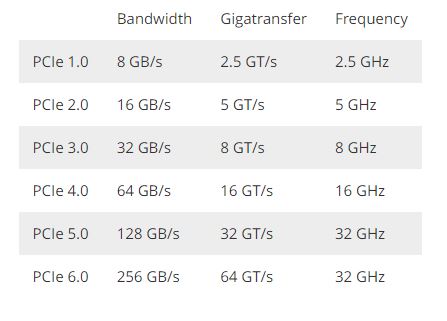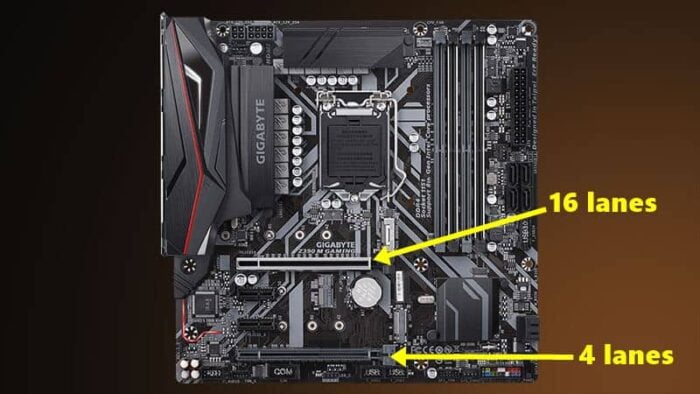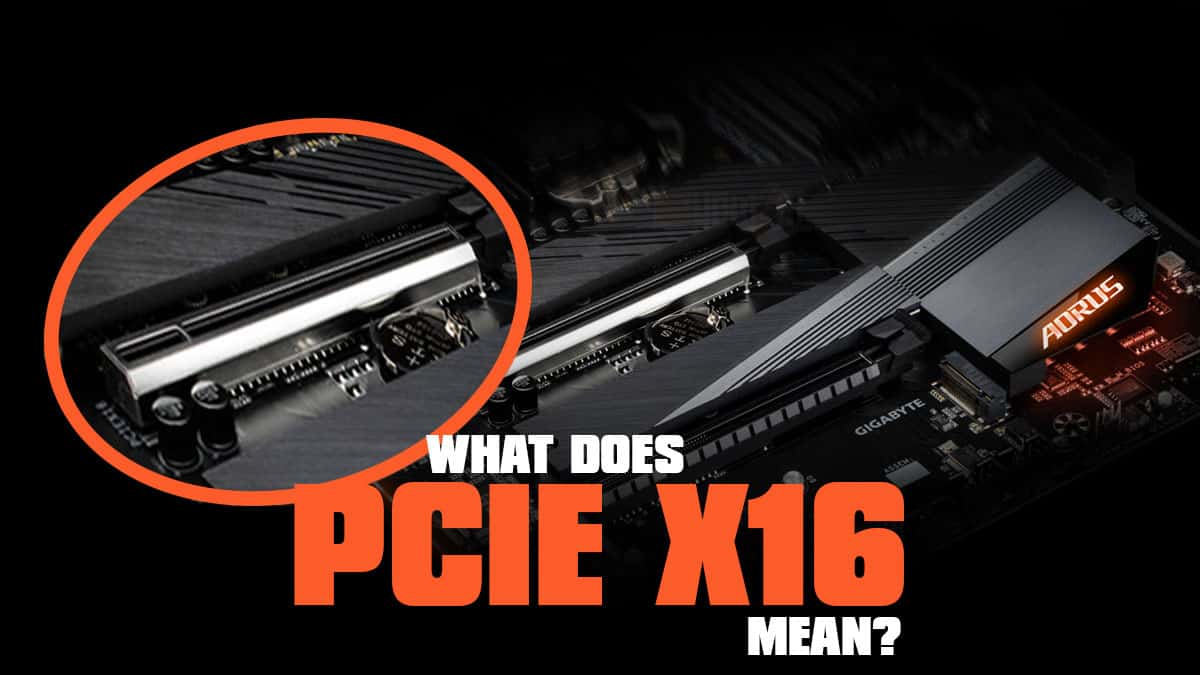I am sure you might have heard about the PCIe x16, but do you know what the PCIe x16 actually is?
PCIe x16 means that the PCIe slot has 16 communication data interfaces in the motherboard interface known as PCIe lanes. PCIe X16 slot provides the highest data transmission speeds. Therefore, it is used for expansion cards that have high bandwidth requirements, such as graphic cards.
From this definition, you can get the general picture of the PCIe X16 slot. Still, modern motherboards are quite customizable and complex. So, you might be curious why we don’t use other PCIe slots instead of the PCIe X16 slot.
In order to get rid of your confusion on the PCIe x16 slot, we need to dig deeper to further see what the PCIe X16 slot really is.
Where Is the PCIe x16 Slot Located on the Motherboard?

You will find the PCIe X16 slot below the CPU socket in most motherboards. However, sometimes, especially on the newer motherboards, there can be an M.2 storage drive between the CPU socket and the PCIe x16 slot.
What Does the PCIe x16 Slot Look Like?

The PCIe slot looks just like the RAM slot and is the largest slot on the motherboard. Typically, a PCIe X16 slot with 16 lanes has a length of 89mm and 82 pins on its surface.
Due to the high pin count, the data transmission rate is faster when compared to a PCIe x1 slot with 18 pins and stands at the length of 25mm.
What Is the PCIe x16 Slot Used For?
The PCIe X16 slot is used for high bandwidth data streaming devices. Given the nature of the slot, the graphics card is the best fit for this PCIe X16 slot.
The graphics card is responsible for rendering the graphics of games, movies, pictures, media, etc. Since pixel rendering takes a lot of power and resources, graphic cards require a large amount of data at the fastest rate possible.
The PCIe X16 slot due to its high data transmission capability fulfills the requirement of the graphics card. Hence, the PCIe X16 slots are mainly used for installing graphic cards on the PC.
What Does the Number 16 Represent in the PCIe X16?
Generally, any number after the X represents the number of lanes available in a PCIe slot. For example, PCIe X4 means 4 lanes in that particular PCIe slot.
Therefore, the 16 letter after the X represents the lanes that the PCIe X16 slot has.
However, lanes do not always work as you would expect. Sometimes, they can be configured differently, so next, let’s look at the PCIe lanes themselves.
What Are PCIe Lanes?
The PCIe lanes are the pipeline through which data is transferred to and from the PCIe slot.
The configuration of lanes is highly dependent on the CPU you have and the motherboard chipset you are using. Generally, most CPUs offer sixteen dedicated PCIe lanes, and a motherboard offers 4 dedicated PCIe lanes through its chipset.
The main difference is that only a true x16 PCIe slot has 16 PCIe lanes. While other PCIe x16 may look the same but they only have 8 or 4 lanes for data transmission. This results in lower bandwidth in PCIe slots that don’t have 16 lanes support.
This difference might be minor, but it is felt when using high-tier expansion cards like GPUs. If you want to know how much performance difference there is, check out my article on which PCIe slot for GPU is ideal.
How a motherboard is set up and configured can also depend on the PCIe version used on the motherboard. The PCIe version is a crucial factor for a motherboard, so let’s look at it.
What Is the Difference Between the Different Generations of PCIe Slot?
Technology is always on the increase, and therefore we see constant improvement in the PCIe X16 slot. Currently, most motherboards use the fourth generation of the PCIe slot. Therefore today, in most motherboards it is not uncommon to find a PCIe 4.0 slot.
However, PCIe 5.0 has been slowly taking over. The gradual mainstream rollout of this technology is becoming imminent and the latest 12th generation Intel Z series motherboards have support for PCIe 5.0.
There are also PCIe 1.0, PCIe 2.0, and PCIe 3.0 slots. PCIe 3.0 version is still lingering around in the old motherboards, but PCIe 1.0 and PCIe 2.0 are not used anymore.
The main difference between all the generations of PCIe slots is the bandwidth capacity. Data transmission speeds have improved with the new generation of PCIe slots.

The above picture shows that the bandwidth speeds have almost doubled with each new generation. This speed increase has had many advantages.
The increase in bandwidth has allowed graphics card technology to improve and advance. Without it, we wouldn’t have been able to see the latest RTX-enabled GPUs with monstrous performance figures.
The bandwidth increase has also allowed for the use of faster storage drives. M.2 NVMe drives would not exist without the improved bandwidth speed that PCIe 4.0 has brought. Today, on the PCIe 4.0 slot, you can use M.2 NVMe drives that exceed the read-write speed of 5 GB/s
When Will PCIe 5.0 Be Available for Mainstream Motherboards?
The PCIe 5.0 standard has been out since May 2019, but only until now it has reached the mass production level. This technology is being adopted at the mainstream level as the Intel 12th generation Z series has it supported.
PCIe 5.0 brings many new exciting changes. Most importantly, the bandwidth has been increased to 128GBps on PCIe 5.0, a significant jump from 64GBps bandwidth on PCIe 4.0.
Another great development regarding PCIe 5.0 is that it will be backward compatible, which is a great relief, especially for people who like to stick to their computers for a while before upgrading.
We hope to see AMD motherboards also carrying support for PCIe 5.0 sooner than later.
Is There Any Possible Chance of PCIe 6.0 Coming in the Future?
PCIe 6.0 technology is in the works. The official specs for PCIe 6.0 have gained formalization in 2021. It is expected that PCIe 6.0 will be released for enterprise-grade hardware in 2023 and will trickle down to consumer-grade hardware in 2024 at the earliest.
I hope that consumers get their hands on this new technology sooner than later because it boosts very exciting improvements.
According to the official specs published by PCI-SIG, PCIe 6.0 has double the bandwidth of PCIe 5.0 carrying the maximum bandwidth support of 256 GB/s. The data transfer rate is up to 64 GT/s per pin from 32 GT/s per pin of PCIe 5.0. These changes will have a significant impact on the PC hardware industry and may shake things up.
What Are the Different Types of PCIe Slots Besides X16?
Apart from the PCIe X16 slot, the PCIe slot also comes in other sizes. The smaller-sized PCIe slots are there to fulfill their purpose. It is not optimal to connect every expansion device to the X16 slot, and this is where the other sizes come into play.
The three other sizes of PCIe slots are as follows.
PCIe X1 slot
The PCIe X1 slot is the smallest expansion slot on the motherboard. Since it is smaller, it has the least number of pins compared to other PCIe slots. As a result, the bandwidth on offer here is also the least.
PCIe X4 Slot
The PCIe X4 is the second smallest size offered for PCIe slots. This slot is convenient for small expansion cards like network cards, sound cards, etc. It has four times the bandwidth of the PCIe X1 slot.
PCIe X8 slot
The PCIe x8 slot is twice as large as the PCIe X4 slots. The PCIe X8 supports high bandwidth transmission and is sometimes used for secondary graphic cards in a dual GPU setup.
Why Are Some PCIe X16 Slots Different?
There is quite a significant difference between some PCIe X16 slots that look the same and have the same size.
The main difference is that only a true x16 PCIe slot has 16 PCIe lanes. While other PCIe x16 slots may look the same but they only have 8 or 4 lanes for data transmission. This results in lower bandwidth in PCIe slots that don’t have true 16 lanes support. If you want to know how much performance difference there is, check out my article on does it matter which PCIe slot I use.

Take the above picture, for example. Only the top PCIe x16 slot qualifies as having 16 lanes true PCIe X16 slot; therefore, you should plug the graphic card in that slot. The bottom X16 slot does not have 16 lanes.
Therefore, the topmost PCIe slot in most motherboards is the fastest because it has 16 lanes. You should use this general rule of thumb when installing your graphic cards.
Which PC Components or Devices Are Used on the PCIe X16 Slot
The PCIe X16 slot is used for expansion cards that require a high amount of bandwidth. Out of all the expansion cards, the one that requires the most bandwidth is the graphics card.
Therefore, mainly graphic cards are used on the PCIe X16 slot, but this slot is not only limited to the graphics card.
Due to its backward compatible nature, you can also use network cards, sound cards, video cards, and even SSD expansion cards on the PCIe X16 slot.
Graphic cards should always be given priority for use with the PCIe X16 slot. You should only install other expansion cards on the PCIe X16 when there is no graphics card to install.
Will a PCIe X1, X4, or X8 Expansion Card Work Faster on PCIe x16 Slot?
No, a PCIe X1, X4, or X8 expansion card will not work faster on a PCIe X16 slot. There is a false pretense that X1, X4, or X8 cards will work faster on the PCIe X16 slot. The inherent technology difference between the different cards cannot be solved just by using the higher bandwidth PCIe X16 slot.
Therefore, the network cards that are made for the PCIe X4 slot will not magically deliver better internet speeds if they are installed on the PCIe X16 slot.
Related Guides
Check out some of our related motherboard buying guides.
- Best Motherboard for Ryzen 5 3600
- Best Motherboard for Ryzen 5 5600X
- Best Motherboard for Ryzen 7 5800X
- Best Motherboard for Ryzen 9 5900X
- Best Motherboards for Gaming
- Best B550 Motherboard
Check out some of the other related motherboard guides.
- How to Update Motherboard Drivers
- Do Motherboards Have Bluetooth?
- What Are Front Panel Connectors?
- How to Connect Front Panel Connectors to the Motherboard?
- How to Connect Power Button to Motherboard?
- PCIe 3.0 vs 2.0 – What’s the Difference and Which Is Better?
Final Thoughts
This was everything you needed to know in order to understand the true nature of a PCIe X16 slot. It was a lot to take in, so even if you have understood the main points, then you are in the position to tell others what the PCIe X16 slot is.
I hope that I was able to convey the information to you in an easy and jargon-free manner. To put it simply, the PCIe X16 slot is the largest PCIe slot on consumer-grade motherboards that supports the highest bandwidth data transfer speeds.
Since the PCIe X16 slot offers the highest bandwidth, it is used for expansion cards that require quick processing, such as the graphics card.
Before I sign off, feel free if you have any trouble understanding anything about the PCIe X16 slot. Also, I would like to know if, before this article, you had your GPU plugged in the correct PCIe X16 slot or not.



The Author Who Worked On This Article
James Gullett
James is an avid gamer turned tech enthusiast. His journey started in arcade centers when super smash bros was all the rave. It was not until he bought his first PC when his interest in technology grew substantially into a passion.